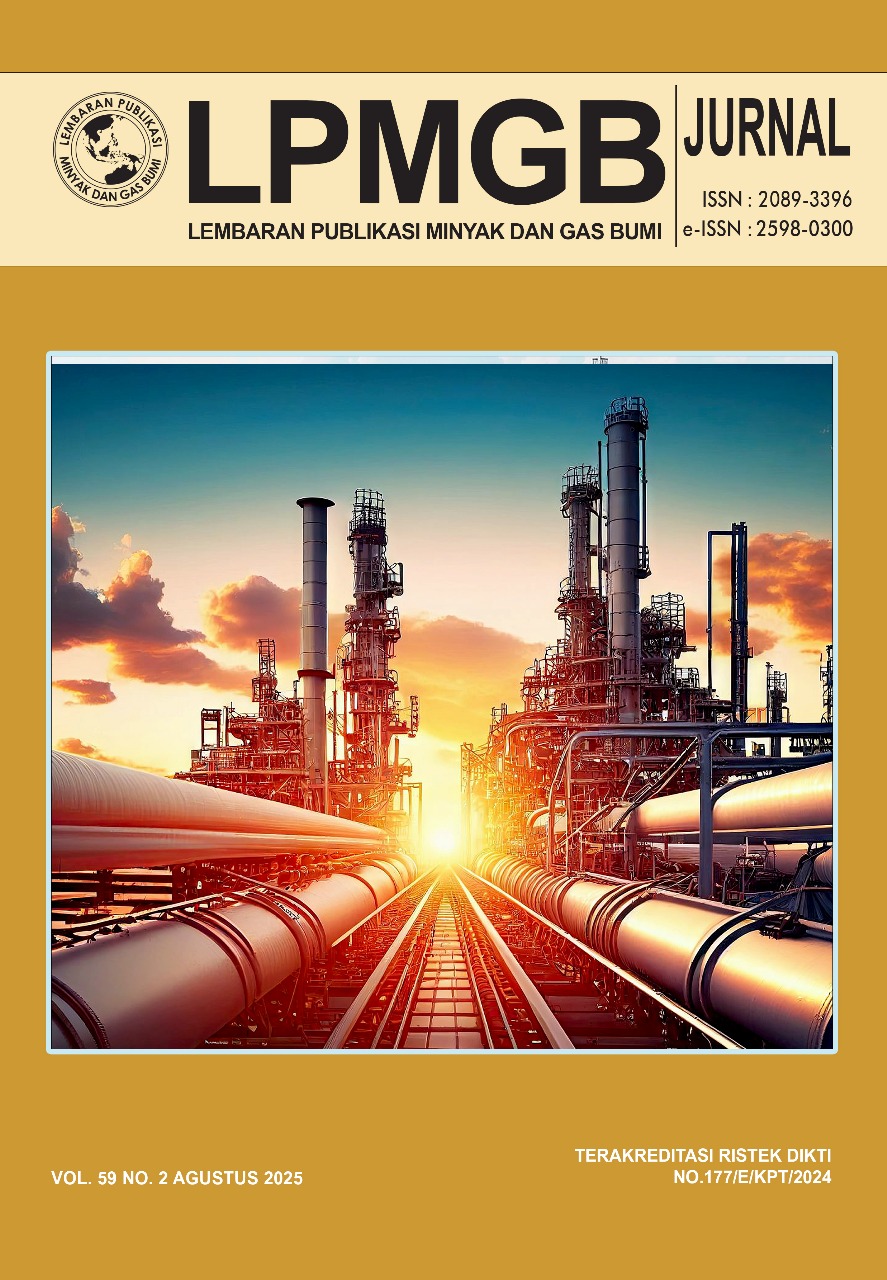Analisis Pengaruh Temperatur, pH dan Laju Alir Terhadap Pembentukan Scale
DOI:
https://doi.org/10.29017/LPMGB.59.2.1785Kata Kunci:
Scale CaCO3, Alat Simulator, Temperatur, pH, Laju AlirAbstrak
The LMN-47 well has the highest scale formation potential compared to other wells in the X field with the highest Scale Index value of 1.39. The condition of this well is also different because the scale formation only occurs in the tubing perforate compared to other wells where scale formation occurs in all pump circuits. The scale formation mechanism is closely related to the content of the formation water and is influenced by temperature, pH, and flow rate parameters. Therefore, testing is needed to determine the scale formation with temperature, pH, and flow rate parameters that are in accordance with the actual conditions in the well through a scale simulator tool. From the simulation on the scale simulator tool designed with a flow rate of 15.2279 liters/minute, pH 7.99 and temperature 56.29 oC, 6.14 grams of carbonate scale (CaCO3) were formed. The results of the analysis proved that the higher the temperature, the faster the growth rate of carbonate scale (CaCO3), the more alkaline the pH, the faster the scale will grow, as well as the flow rate which is directly proportional to temperature and pH.
Referensi
Bradley, Petroleum Engineering Handbook, Society of Petroleum Engineers, US, 1987.
R. Liestyana, L. Said and R. Pratiwi, Analisa Air Formasi Terhadap Kecenderungan Pembentukan Scale Calsium Carbonate (CaCO3) dan Calsium Sulfate(CaSO4), 2018.
R. Isopescu, C. Mateescu, M. Mihai and G. Dabija, "the effects of organic additives on induction time and characterustics calcium carbonate, Chamical Engeneering Research and design, 388, no. 5.," 2010.
S. Muryanto, A. Bayuseno, H. Ma'mun, M. Usamah and Jotho, "Calcium carbonate scale formation in pipes: effect of flow rates, temperature, and malic acid as addictive on the mass and morphology of the scale," 2013.
Rasako, S. N. S., Indriani, E., & Pattikayhatu, E. B. (2024). Evaluasi Penggantian Artificial Lift Sucker Rod Pump (SRP) Menjadi Electrical Submersible Pump (ESP) Untuk Meningkatkan Produksi Minyak Sumur S Lapangan Kawengan. LEMBARAN PUBLIKASI MINYAK DAN GAS BUMI (LPMGB), 58(1), 51-62. https://doi.org/10.29017/LPMGB.58.1.1615
D. O. C. Engineering, "Effect Of Temperature and Solution pH on Calcium Carbonate Precipitation As Bio-Based Repair Material In Concrete," 2024.
H. Ma'mun, A. Bayuseno and S. Muryanto, "Pembentukan Kerak Kalsium Karbonat (CaCO3) didalam Pipa Beraliran Laminer Pada Laju Alir 30 ml/menit Hingga 50ml/menit dan Penambahan Adiktif Asam Malat," 2013.
A. Koerchef and M. Touaibi, "Effect of pH and temperature on calcium carbonate precipitation by CO2 removal from ion-ion rich water," 2019.
D. I. Astuti, S. R. Gusmawarni and M. S. P. Budi, "Studi Perkiraan Potensi Pembentukan Indeks Scale Calcium Carbonate Dari Sampel Brine Sintetik (Variabel CO3 dalam Air Formasi)," 2024.
A. Gusfarozi, "Analisis Penyebab Terbentuknya Scale pada Pipa Produksi di Lapangan X dengan Metode Stiff & Davis dan Metode Skillman, McDonald, Davis. Perpustakaan Universitas Islam Riau. Universitas Islam Riau.," 2021.
E. C. Saputra, "Analisa Variasi Temperature Pembentukan Kristal CaCO3 Pada Consentrasi Larutan 3500 ppm Ca++ Dengan Laju Alir 50 ml/menit," 2015.
Yusrizal, M. Z., & Kaesti, E. Y. (2025). Modern Palacio-Blasingame Type Curve Method to Determine Well Production Characteristics and Reserves in Indonesia Field. Scientific Contributions Oil and Gas, 48(3), 120-130.
Unduhan
Diterbitkan
Terbitan
Bagian
Lisensi
Hak Cipta (c) 2025 © Copyright by Authors. Published by LEMIGAS

Artikel ini berlisensiCreative Commons Attribution-ShareAlike 4.0 International License.











